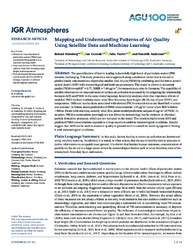Mapping and Understanding Patterns of Air Quality Using Satellite Data and Machine Learning
DOI: https://doi.org/10.1029/2019JD031380
Persistent URL: http://resolver.sub.uni-goettingen.de/purl?gldocs-11858/9354
Persistent URL: http://resolver.sub.uni-goettingen.de/purl?gldocs-11858/9354
Stirnberg, Roland; Cermak, Jan; Fuchs, Julia; Andersen, Hendrik, 2020: Mapping and Understanding Patterns of Air Quality Using Satellite Data and Machine Learning. In: Journal of Geophysical Research: Atmospheres, Band 125, 4, DOI: 10.1029/2019JD031380.
 |
Dokument öffnen: |
The quantification of factors leading to harmfully high levels of particulate matter (PM) remains challenging. This study presents a novel approach using a statistical model that is trained to predict hourly concentrations of particles smaller than 10
μm (PM10) by combining satellite-borne aerosol optical depth (AOD) with meteorological and land-use parameters. The model is shown to accurately predict PM10 (overall R
2 = 0.77, RMSE = 7.44
μg/m
3) for measurement sites in Germany. The capability of satellite observations to map and monitor surface air pollution is assessed by investigating the relationship between AOD and PM10 in the same modeling setup. Sensitivity analyses show that important drivers of modeled PM10 include multiday mean wind flow, boundary layer height (BLH), day of year (DOY), and temperature. Different mechanisms associated with elevated PM10 concentrations are identified in winter and summer. In winter, mean predictions of PM10 concentrations >35
μg/m
3 occur when BLH is below
∼500 m. Paired with multiday easterly wind flow, mean model predictions surpass 40
μg/m
3 of PM10. In summer, PM10 concentrations seemingly are less driven by meteorology, but by emission or chemical particle formation processes, which are not included in the model. The relationship between AOD and predicted PM10 concentrations depends to a large extent on ambient meteorological conditions. Results suggest that AOD can be used to assess air quality at ground level in a machine learning approach linking it with meteorological conditions.
Statistik:
ZugriffsstatistikSammlung:
This is an open access article under the terms of the Creative Commons Attribution License, which permits use, distribution and reproduction in any medium, provided the original work is properly cited.

